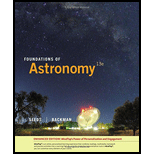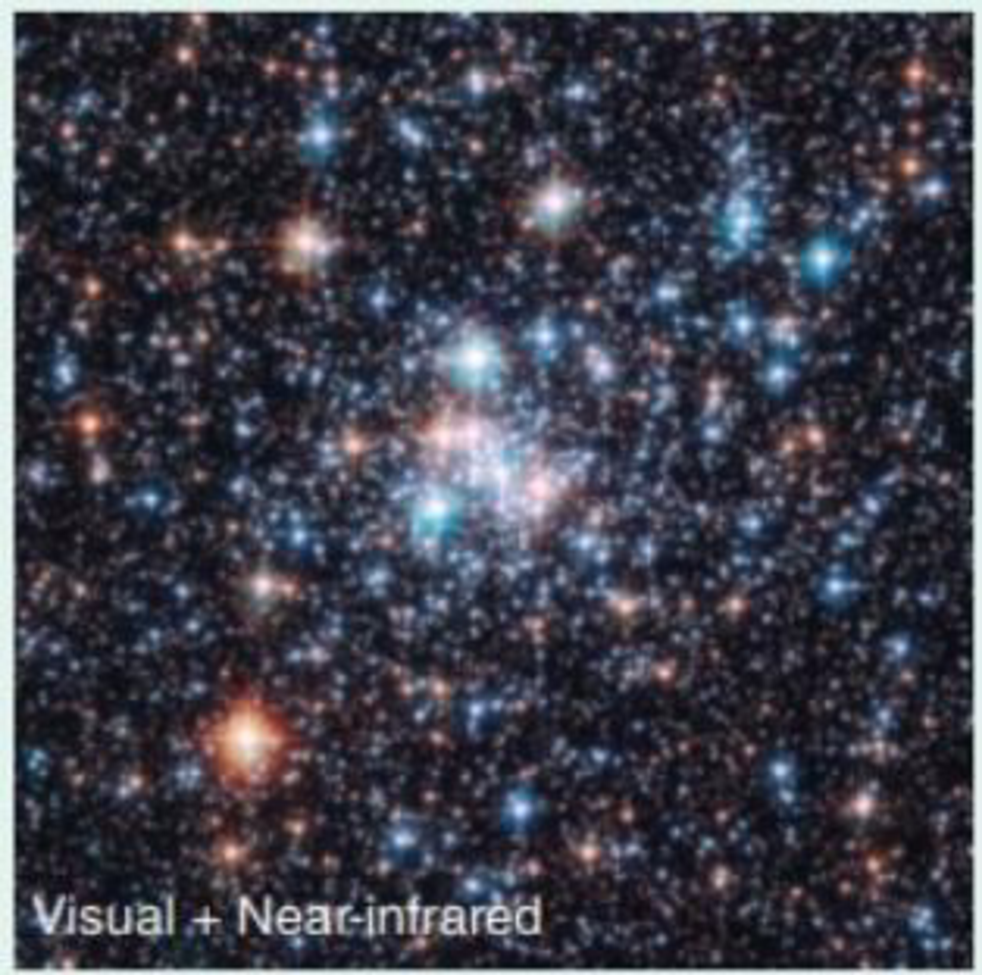
Foundations of Astronomy, Enhanced
13th Edition
ISBN: 9781305980686
Author: Michael A. Seeds; Dana Backman
Publisher: Cengage Learning US
expand_more
expand_more
format_list_bulleted
Concept explainers
Textbook Question
Chapter 26, Problem 2LTL
The star cluster shown in this image contains a few red giants as well as main-sequence stars ranging from spectral type B to M. Discuss the likelihood that exoplanets orbiting any of these stars might be home to life. (Hint: Estimate the age of the cluster.)

Expert Solution & Answer
Trending nowThis is a popular solution!

Students have asked these similar questions
No chatgpt pls will upvote instant
Kirchoff's Laws. A circuit contains 3 known resistors, 2 known batteries, and 3 unknown currents as shown.
Assume the current flows through the circuit as shown (this is our initial guess, the actual currents may be
reverse). Use the sign convention that a potential drop is negative and a potential gain is positive.
E₂ = 8V
R₁₁ = 50
R₂ = 80
b
с
w
11
www
12
13
E₁ = 6V
R3 = 20
a) Apply Kirchoff's Loop Rule around loop abefa in the clockwise direction starting at point a. (2 pt).
b) Apply Kirchoff's Loop Rule around loop bcdeb in the clockwise direction starting at point b. (2 pt).
c) Apply Kirchoff's Junction Rule at junction b (1 pt).
d) Solve the above 3 equations for the unknown currents I1, 12, and 13 and specify the direction of the current
around each loop. (5 pts)
I1 =
A
12 =
A
13 =
A
Direction of current around loop abef
Direction of current around loop bcde
(CW or CCW)
(CW or CCW)
No chatgpt pls will upvote
Chapter 26 Solutions
Foundations of Astronomy, Enhanced
Ch. 26 - Explain how astrobiology is a science and not a...Ch. 26 - Prob. 2RQCh. 26 - Prob. 3RQCh. 26 - How does the DNA molecule produce a copy of...Ch. 26 - What would happen to a life-form if the genetic...Ch. 26 - What would happen to a life-form if the genetic...Ch. 26 - What would happen to a life-form if the...Ch. 26 - Describe an example of natural selection acting on...Ch. 26 - Prob. 9RQCh. 26 - What evidence do scientists have that life on...
Ch. 26 - Prob. 11RQCh. 26 - Why is liquid water generally considered necessary...Ch. 26 - Prob. 13RQCh. 26 - What is the difference between chemical evolution...Ch. 26 - Prob. 15RQCh. 26 - Why was Earths early atmosphere able to support...Ch. 26 - Molecules of which gas were needed in Earths...Ch. 26 - Does intelligence make a creature more likely to...Ch. 26 - Prob. 19RQCh. 26 - Prob. 20RQCh. 26 - What is the evidence that the first organisms on...Ch. 26 - Name three locations in our Solar System to search...Ch. 26 - Why are upper-main-sequence (high-luminosity) host...Ch. 26 - Prob. 24RQCh. 26 - How does the stability of technological...Ch. 26 - Prob. 26RQCh. 26 - Prob. 27RQCh. 26 - Why are scientists confident Earth has never been...Ch. 26 - Why does the Drake equation implicitly assume the...Ch. 26 - Prob. 1DQCh. 26 - Prob. 2DQCh. 26 - Prob. 3DQCh. 26 - Prob. 4DQCh. 26 - Prob. 5DQCh. 26 - A single human cell encloses about 1.5 m of DNA....Ch. 26 - If you represent Earths history by a line that is...Ch. 26 - Consider Figure 25-8. What is the ratio of the...Ch. 26 - Suppose a human generation is defined as the...Ch. 26 - If a star must remain on the main sequence for at...Ch. 26 - Prob. 6PCh. 26 - If you detected radio signals with an average...Ch. 26 - Prob. 8PCh. 26 - The first radio broadcast was made on January 13,...Ch. 26 - Prob. 10PCh. 26 - Look at Figure 25-11. Since the time we sent the...Ch. 26 - The star cluster shown in this image contains a...Ch. 26 - If you could search for life in the galaxy shown...
Knowledge Booster
Learn more about
Need a deep-dive on the concept behind this application? Look no further. Learn more about this topic, physics and related others by exploring similar questions and additional content below.Similar questions
- 4.) The diagram shows the electric field lines of a positively charged conducting sphere of radius R and charge Q. A B Points A and B are located on the same field line. A proton is placed at A and released from rest. The magnitude of the work done by the electric field in moving the proton from A to B is 1.7×10-16 J. Point A is at a distance of 5.0×10-2m from the centre of the sphere. Point B is at a distance of 1.0×10-1 m from the centre of the sphere. (a) Explain why the electric potential decreases from A to B. [2] (b) Draw, on the axes, the variation of electric potential V with distance r from the centre of the sphere. R [2] (c(i)) Calculate the electric potential difference between points A and B. [1] (c(ii)) Determine the charge Q of the sphere. [2] (d) The concept of potential is also used in the context of gravitational fields. Suggest why scientists developed a common terminology to describe different types of fields. [1]arrow_forward3.) The graph shows how current I varies with potential difference V across a component X. 904 80- 70- 60- 50- I/MA 40- 30- 20- 10- 0+ 0 0.5 1.0 1.5 2.0 2.5 3.0 3.5 4.0 4.5 5.0 VIV Component X and a cell of negligible internal resistance are placed in a circuit. A variable resistor R is connected in series with component X. The ammeter reads 20mA. 4.0V 4.0V Component X and the cell are now placed in a potential divider circuit. (a) Outline why component X is considered non-ohmic. [1] (b(i)) Determine the resistance of the variable resistor. [3] (b(ii)) Calculate the power dissipated in the circuit. [1] (c(i)) State the range of current that the ammeter can measure as the slider S of the potential divider is moved from Q to P. [1] (c(ii)) Describe, by reference to your answer for (c)(i), the advantage of the potential divider arrangement over the arrangement in (b).arrow_forward1.) Two long parallel current-carrying wires P and Q are separated by 0.10 m. The current in wire P is 5.0 A. The magnetic force on a length of 0.50 m of wire P due to the current in wire Q is 2.0 × 10-s N. (a) State and explain the magnitude of the force on a length of 0.50 m of wire Q due to the current in P. [2] (b) Calculate the current in wire Q. [2] (c) Another current-carrying wire R is placed parallel to wires P and Q and halfway between them as shown. wire P wire R wire Q 0.05 m 0.05 m The net magnetic force on wire Q is now zero. (c.i) State the direction of the current in R, relative to the current in P.[1] (c.ii) Deduce the current in R. [2]arrow_forward
- 2.) A 50.0 resistor is connected to a cell of emf 3.00 V. The voltmeter and the ammeter in the circuit are ideal. V A 50.00 (a) The current in the ammeter is 59.0 mA. Calculate the internal resistance of the cell. The circuit is changed by connecting another resistor R in parallel to the 50.0 resistor. V A 50.00 R (b) Explain the effect of this change on R is made of a resistive wire of uniform cross-sectional area 3.1 × 10-8 m², resistivity 4.9 × 10-70m and length L. The resistance of R is given by the equation R = KL where k is a constant. (b.i) the reading of the ammeter. [2] (b.ii) the reading of the voltmeter. [2] (c) Calculate k. State an appropriate unit for your answer. [3] [2]arrow_forwardNo chatgpt pls will upvotearrow_forwardNo chatgpt pls will upvotearrow_forward
- A rod 12.0 cm long is uniformly charged and has a total charge of -20.0 μc. Determine the magnitude and direction of the electric field along the axis of the rod at a point 32.0 cm from its center. 361000 ☑ magnitude What is the general expression for the electric field along the axis of a uniform rod? N/C direction toward the rodarrow_forwardA certain brand of freezer is advertised to use 730 kW h of energy per year. Part A Assuming the freezer operates for 5 hours each day, how much power does it require while operating? Express your answer in watts. ΜΕ ΑΣΦ ? P Submit Request Answer Part B W If the freezer keeps its interior at a temperature of -6.0° C in a 20.0° C room, what is its theoretical maximum performance coefficient? Enter your answer numerically. K = ΜΕ ΑΣΦ Submit Request Answer Part C What is the theoretical maximum amount of ice this freezer could make in an hour, starting with water at 20.0°C? Express your answer in kilograms. m = Ο ΑΣΦ kgarrow_forwardDescribe the development of rational choice theory in sociology. Please includearrow_forward
- A-E pleasearrow_forwardA 11.8 L gas tank containing 3.90 moles of ideal He gas at 26.0°C is placed inside a completely evacuated insulated bell jar of volume 39.0 L .A small hole in the tank allows the He to leak out into the jar until the gas reaches a final equilibrium state with no more leakage. Part A What is the change in entropy of this system due to the leaking of the gas? ■ ΜΕ ΑΣΦ AS = ? J/K Submit Request Answer Part B Is the process reversible or irreversible?arrow_forwardA-E pleasearrow_forward
arrow_back_ios
SEE MORE QUESTIONS
arrow_forward_ios
Recommended textbooks for you

 Stars and Galaxies (MindTap Course List)PhysicsISBN:9781337399944Author:Michael A. SeedsPublisher:Cengage Learning
Stars and Galaxies (MindTap Course List)PhysicsISBN:9781337399944Author:Michael A. SeedsPublisher:Cengage Learning Foundations of Astronomy (MindTap Course List)PhysicsISBN:9781337399920Author:Michael A. Seeds, Dana BackmanPublisher:Cengage Learning
Foundations of Astronomy (MindTap Course List)PhysicsISBN:9781337399920Author:Michael A. Seeds, Dana BackmanPublisher:Cengage Learning
 AstronomyPhysicsISBN:9781938168284Author:Andrew Fraknoi; David Morrison; Sidney C. WolffPublisher:OpenStax
AstronomyPhysicsISBN:9781938168284Author:Andrew Fraknoi; David Morrison; Sidney C. WolffPublisher:OpenStax Horizons: Exploring the Universe (MindTap Course ...PhysicsISBN:9781305960961Author:Michael A. Seeds, Dana BackmanPublisher:Cengage Learning
Horizons: Exploring the Universe (MindTap Course ...PhysicsISBN:9781305960961Author:Michael A. Seeds, Dana BackmanPublisher:Cengage Learning


Stars and Galaxies (MindTap Course List)
Physics
ISBN:9781337399944
Author:Michael A. Seeds
Publisher:Cengage Learning

Foundations of Astronomy (MindTap Course List)
Physics
ISBN:9781337399920
Author:Michael A. Seeds, Dana Backman
Publisher:Cengage Learning


Astronomy
Physics
ISBN:9781938168284
Author:Andrew Fraknoi; David Morrison; Sidney C. Wolff
Publisher:OpenStax

Horizons: Exploring the Universe (MindTap Course ...
Physics
ISBN:9781305960961
Author:Michael A. Seeds, Dana Backman
Publisher:Cengage Learning
General Relativity: The Curvature of Spacetime; Author: Professor Dave Explains;https://www.youtube.com/watch?v=R7V3koyL7Mc;License: Standard YouTube License, CC-BY